DanshenDanshenSALVIAE MILTIORRHIZAE RADIX ET RHIZOMA1. 2020 Edition of the Chinese Pharmacopoeia
This product is the dried root and rhizome of the plant Danshen (Salvia miltiorrhiza Bge.) from the Lamiaceae family. It is harvested in spring and autumn, cleaned of soil, and dried.
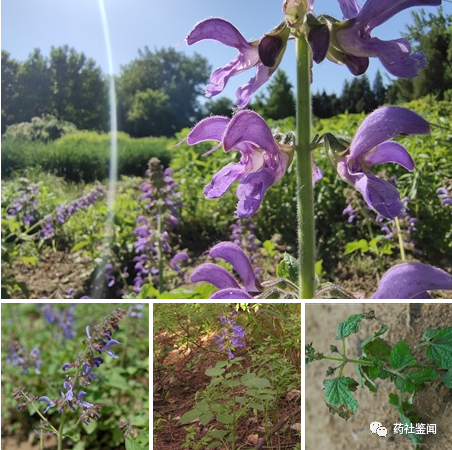
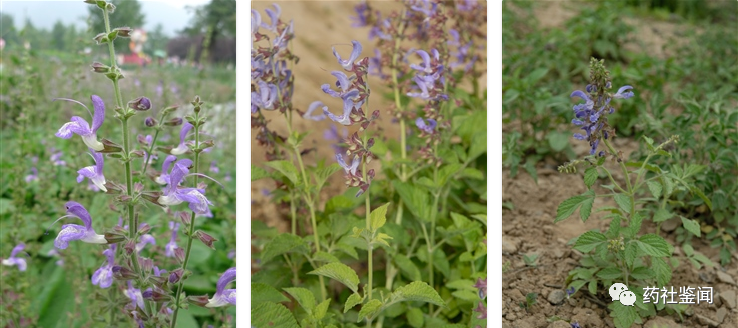
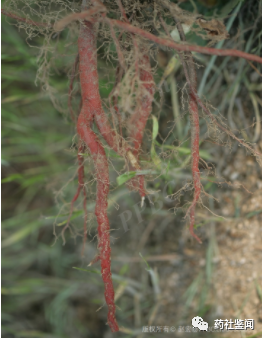
【Properties】 The rhizome is short and thick, sometimes with remnants of the stem base at the top. The roots are cylindrical, slightly curved, with some branching and fibrous roots, measuring 10-20 cm in length and 0.3-1 cm in diameter. The surface is reddish-brown or dark reddish-brown, rough, with longitudinal wrinkles. The outer skin of older roots is loose, often showing a purple-brown color, and may flake off in scales. The texture is hard and brittle, with a loose fracture surface that may have cracks or be slightly smooth and dense. The bark is reddish-brown, the wood is grayish-yellow or purple-brown, and the vascular bundles are yellowish-white, arranged radially. The aroma is faint, and the taste is slightly bitter.
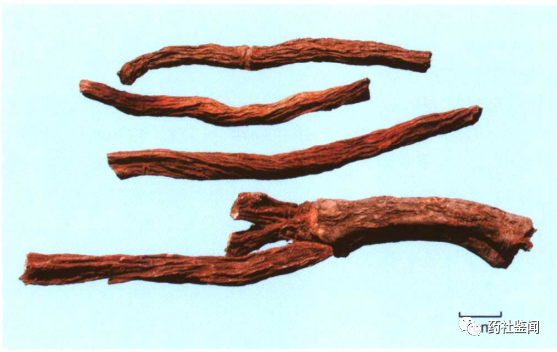

Cultivated specimens are sturdier, with a diameter of 0.5-1.5 cm. The surface is reddish-brown, with longitudinal wrinkles, and the outer skin is tightly adhered and not easily peeled off. The texture is solid, with a relatively smooth fracture surface, slightly keratinous in appearance. 【Identification】 (1) The powder of this product is reddish-brown. Stone cells are round, triangular, rectangular, or irregularly shaped, some elongated and fibrous, with uneven edges, measuring 14-70 μm in diameter and up to 257 μm in length, with obvious pores, some containing yellow-brown substances. Wood fibers are mostly fiber tube cells, elongated, with pointed or blunt ends, measuring 12-27 μm in diameter, with bordered pit pores that are slit-like or cross-shaped, sparsely distributed. Reticulate vessels and bordered pit vessels measure 11-60 μm in diameter. (2) Take 1 g of the powdered product, add 5 ml of ethanol, sonicate for 15 minutes, centrifuge, and take the supernatant as the test solution. Take 1 g of the reference herb Danshen and prepare the reference solution in the same manner. Then take reference substances Danshenone II A and Danshensu, and prepare a mixed solution containing 0.5 mg and 1.5 mg per 1 ml, respectively, as reference solutions. Perform thin-layer chromatography (TLC) tests according to the general method 0502, applying 5 μl of each of the three solutions onto the same silica gel G plate, developing with chloroform-toluene-ethyl acetate-methanol-formic acid (6:4:8:1:4) as the mobile phase, and developing to about 4 cm. Remove, dry, and then develop with petroleum ether (60-90℃)-ethyl acetate (4:1) to about 8 cm, remove, dry, and examine under sunlight and ultraviolet light (365 nm). In the test solution, spots of the same color or fluorescent spots should appear at the corresponding positions as in the reference herb and reference substance chromatograms. 【Testing】 Moisture content must not exceed 13.0% (General Rule 0832, Method 2). Total ash content must not exceed 10.0% (General Rule 2302). Acid-insoluble ash must not exceed 3.0% (General Rule 2302). Heavy metals and harmful elements are determined according to the methods for lead, cadmium, arsenic, mercury, and copper (General Rule 2321, atomic absorption spectrophotometry or inductively coupled plasma mass spectrometry), with lead not exceeding 5 mg/kg; cadmium not exceeding 1 mg/kg; arsenic not exceeding 2 mg/kg; mercury not exceeding 0.2 mg/kg; copper not exceeding 20 mg/kg. 【Extractives】 Water-soluble extractives are determined by the cold soaking method (General Rule 2201) and must not be less than 35.0%. Alcohol-soluble extractives are determined by the hot soaking method (General Rule 2201) using ethanol as the solvent and must not be less than 15.0%. 【Content Determination】 Danshenones are determined by high-performance liquid chromatography (HPLC) (General Rule 0512). Chromatographic conditions and system suitability tests use octadecyl silane-bonded silica gel as the stationary phase; acetonitrile as mobile phase A, and 0.02% phosphoric acid solution as mobile phase B, performing gradient elution as specified in the table; column temperature at 20℃; detection wavelength at 270 nm. Theoretical plate number based on the peak of Danshenone II A should not be less than 60000. Preparation of reference solution: Take an appropriate amount of Danshenone II A reference substance, accurately weigh, place in a brown volumetric flask, and add methanol to prepare a solution containing 20 μg per 1 ml. Preparation of test solution: Take about 0.3 g of the powdered product (passed through a No. 3 sieve), accurately weigh, place in a stoppered conical flask, accurately add 50 ml of methanol, seal tightly, weigh, sonicate (power 140W, frequency 42kHz) for 30 minutes, cool, reweigh, and use methanol to make up for the weight loss, shake well, filter, and take the filtrate. Measurement method: Accurately take 10 μl of both the reference solution and the test solution, inject into the liquid chromatography system for measurement. Use the peak of Danshenone II A as a reference, and calculate the relative retention times of hidden Danshenone and Danshenone I, which should be within ±5% of the specified value. Relative retention times and correction factors are shown in the table. Based on the peak area of Danshenone II A as a reference, multiply by the correction factor to calculate the content of hidden Danshenone, Danshenone I, and Danshenone II A. The product, calculated on a dry basis, must contain not less than 0.25% of Danshenone II A (C19H18O3), hidden Danshenone (C19H20O3), and Danshenone I (C18H12O3). Danshensu is determined by HPLC (General Rule 0512). Chromatographic conditions and system suitability tests use octadecyl silane-bonded silica gel as the stationary phase; acetonitrile-0.1% phosphoric acid solution (22:78) as the mobile phase; column temperature at 20℃; flow rate at 1.2 ml/min; detection wavelength at 286 nm. Theoretical plate number based on the peak of Danshensu should not be less than 6000. Preparation of reference solution: Take an appropriate amount of Danshensu reference substance, accurately weigh, and prepare a solution containing 0.10 mg per 1 ml using a methanol-water (8:2) mixture. Preparation of test solution: Take about 0.15 g of the powdered product (passed through a No. 3 sieve), accurately weigh, place in a stoppered conical flask, accurately add 50 ml of a methanol-water (8:2) mixture, seal tightly, weigh, sonicate (power 140W, frequency 42kHz) for 30 minutes, cool, reweigh, and use the methanol-water (8:2) mixture to make up for the weight loss, shake well, filter, accurately take 5 ml of the filtrate, transfer to a 10 ml volumetric flask, dilute to the mark with the methanol-water (8:2) mixture, shake well, filter, and take the filtrate. Measurement method: Accurately take 10 μl of both the reference solution and the test solution, inject into the liquid chromatography system for measurement. The product, calculated on a dry basis, must contain not less than 3.0% of Danshensu (C36H30O16).
2. Chinese Herbal Pieces
【Processing】 Danshen: Remove impurities and residual stems, wash, moisten, cut into thick slices, and dry. 【Properties】 The product appears as thick, round or oval slices. The outer skin is reddish-brown or dark reddish-brown, rough, with longitudinal wrinkles. The cut surface may have cracks or be slightly smooth and dense, with a reddish-brown bark, grayish-yellow or purple-brown wood, and yellowish-white radial patterns. The aroma is faint, and the taste is slightly bitter.
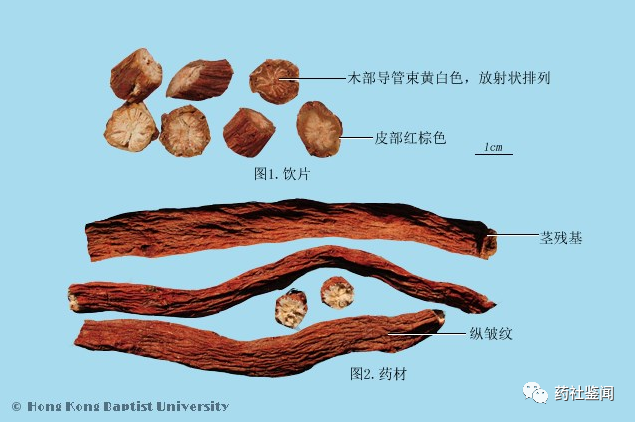
【Testing】 Acid-insoluble ash must not exceed 2.0% (General Rule 2302). 【Extractives】 Alcohol-soluble extractives must not be less than 11.0%. 【Identification】【Testing】 (Moisture content, Total ash content) 【Extractives】 (Water-soluble extractives) Same as the herb. Wine Danshen: Take Danshen slices and stir-fry them according to the wine-frying method (General Rule 0213) until dry. 【Properties】 The product resembles Danshen slices, with a reddish-brown surface and a slight wine aroma. 【Testing】 Moisture content must not exceed 10.0% (General Rule 0832, Method 2). 【Extractives】 Alcohol-soluble extractives must not be less than 11.0%. 【Identification】【Testing】 (Total ash content) 【Extractives】 (Water-soluble extractives) Same as the herb. 【Taste and Meridian Entry】 Bitter, slightly cold. Enters the Heart and Liver meridians. 【Functions and Indications】 Invigorates blood, dispels stasis, regulates menstruation, alleviates pain, clears the heart, relieves irritability, cools the blood, and resolves abscesses. Used for chest pain, abdominal pain, masses, heat-induced pain, irritability, insomnia, irregular menstruation, dysmenorrhea, and painful obstruction. 【Dosage】 10-15 g. 【Cautions】 Should not be used with Li Lu. 【Storage】 Store in a dry place. 3. Authenticity Identification 1. Authentic Danshen The herb is the dried root and rhizome of the plant Danshen (Salvia miltiorrhiza Bge.) from the Lamiaceae family. The rhizome is short and thick, sometimes with remnants of the stem base at the top; the roots are cylindrical, slightly curved, with some branching and fibrous roots. The entire length is 10-20 cm, with a diameter of 0.3-1 cm. The surface is reddish-brown or dark reddish-brown, rough, with longitudinal wrinkles, and some outer skin is loose, easily flaking off, often showing a purple-brown color. The texture is hard and brittle, easily broken, with a fracture surface that has cracks, the bark is reddish-brown, the wood is grayish-yellow or purple-brown, with obvious radial patterns. The aroma is faint, and the taste is slightly bitter. Cultivated specimens are sturdier, with fewer branches, measuring 0.5-2 cm in diameter. The surface is reddish-brown, with longitudinal wrinkles, and the outer skin is tightly adhered and not easily peeled off. The texture is solid, with a relatively smooth fracture surface, slightly keratinous in appearance.
2. Non-authentic Product: Brown-haired Salvia (Salvia przewalskii Maxim. var. mandarinorum Stib.) The dried root and rhizome of this plant are conical, with a prominent main root, and the top shows parallel cylindrical stem remnants. It measures 15-25 cm in length and 3-6 cm in diameter. The surface is purple-brown or reddish-brown, with twisted longitudinal grooves, and the outer skin may flake off in scales and strips. The texture is loose and brittle, easily broken. The fracture surface is loose and very irregular. The wood has light yellow spots scattered throughout. The aroma is faint, and the taste is slightly bitter.
3. Non-authentic Product: Yunnan Danshen (Purple Danshen) (Salvia yunnanensis C.H. Wright) (1) Alias: Danshen is also known as Chi Shen, Purple Danshen, and Red Root. It is a dicotyledonous plant from the Lamiaceae family, consisting of dried roots and rhizomes. It is mainly produced in Anhui, Henan, and Shaanxi provinces. Efficacy: Invigorates blood, regulates menstruation, dispels stasis, cools the blood, clears the heart, and calms the spirit. Small Purple Danshen, Small Danshen, Yunnan Purple Danshen, and Yunnan Danshen are named so because their roots are smaller than those of Danshen (Salvia miltiorrhiza Bge.) listed in the Pharmacopoeia of the People's Republic of China, and they are mainly produced and sold in Yunnan. (2) Effects: According to the "Yunnan Materia Medica": "Danshen has a slightly bitter taste and a slightly cold nature. It is red in color and enters the Heart meridian. It nourishes the heart, generates blood, nourishes the heart, calms the mind, alleviates forgetfulness, palpitations, insomnia, generates new blood, dispels stasis, supports pregnancy, and prevents miscarriage. It can replace the blood-nourishing effects of the Four Substance Decoction." This product is one of the varieties of Danshen used medicinally in Yunnan for a long time and has been included in the 1974 and 1996 editions of the Yunnan Provincial Drug Standards. Purple Danshen is the root of the plant Yunnan Salvia (Salvia yunnanensis C.H. Wright) from the Lamiaceae family. (3) Properties: The root and rhizome are short, with dense stem remnants or petiole remnants, measuring 0.4-1 cm in diameter. The roots are spindle-shaped and clustered, measuring 5-10 cm in length and 0.2-0.7 cm in diameter. The surface is dark reddish-brown and rough. The texture, fracture surface, and aroma are similar to Danshen. (4) Main Distribution: Eastern, central, and northwestern Yunnan. It grows on slopes, grasslands, forest edges, roadside shrubs, or dry land at altitudes of 1800-2900 m. (5) Production Areas: Mainly in Shanxi, Hubei, Shaanxi, Shandong, Henan, and Anhui provinces, mostly wild specimens, while Sichuan has mostly cultivated specimens. Yunnan has long used Danshen for medicinal purposes and sells it outside the province.
4. Non-authentic Product: Pseudo-Danshen (Salvia sinica Migo) The dried root of this plant is cylindrical and often curved, measuring 5-20 cm in length and 0.2-1.2 cm in diameter. The surface is brownish, with wrinkles. The texture is hard, easily broken, with the bark and wood parts separating, and the wood is light yellowish-white. The aroma is faint, and the taste is slightly bitter.
5. Non-authentic Product: Woolly Digitalis Tail (Salvia digitaloides Diels) The dried root of this plant is slender, often with several intertwined roots, measuring 15 cm in length and 0.5 cm in diameter. The surface is light reddish-brown. The texture is soft, easily broken, with the wood being yellowish-white. The aroma is faint, and the taste is slightly bitter.
4. Specifications and Grades 1. Danshen: This product is the dried root and rhizome of the plant Danshen (Salvia miltiorrhiza Bge.) from the Lamiaceae family. It is harvested in spring and autumn, cleaned of soil, and dried. 2. Specifications: Danshen herbs are classified during circulation based on different trading categories. Note: According to market circulation conditions and different production areas, Danshen herbs are divided into "Sichuan Danshen," "Shandong Danshen," and "Danshen from other regions" three specifications. Whether to grade the herbs is divided into "selected goods" and "common goods" two specifications. 3. Grades: Under each specification of Danshen herbs, the trading varieties are classified based on the quality of Danshen. Note: Based on the diameter and length of the main root, the "selected goods" specification of Sichuan Danshen is divided into "special grade," "first grade," "second grade," and "third grade," while the "selected goods" specification of Shandong Danshen is divided into "first grade" and "second grade." 4. Sichuan Danshen: Produced in Zhongjiang County and surrounding areas of Sichuan Province, commonly referred to as "Sichuan Danshen." 5. Shandong Danshen: Produced in Linyi, Tai'an, Rizhao, Weifang, Zibo, Jining, and surrounding areas of Shandong Province, commonly referred to as "Shandong Danshen." 6. Specification and grade classification should meet the requirements of Table 1, and the characteristics diagram can be found in Appendix A.







